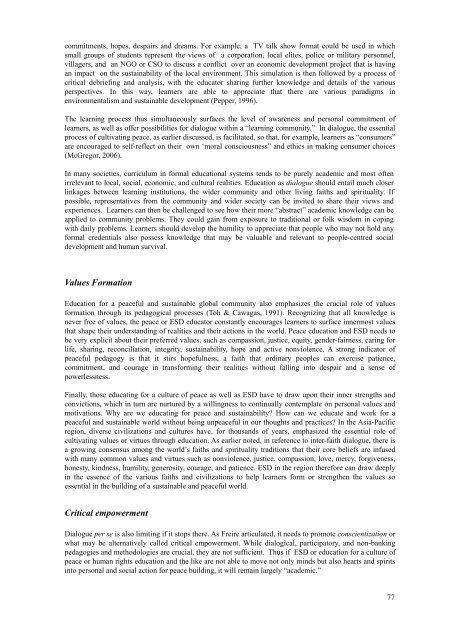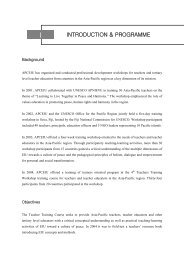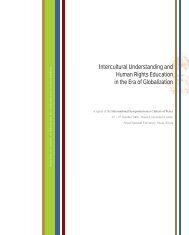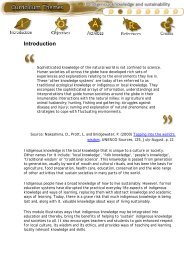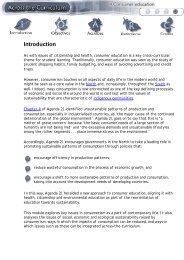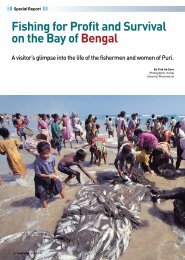REPORT OF UNESCO EXPERT MEETING ON - APCEIU
REPORT OF UNESCO EXPERT MEETING ON - APCEIU
REPORT OF UNESCO EXPERT MEETING ON - APCEIU
You also want an ePaper? Increase the reach of your titles
YUMPU automatically turns print PDFs into web optimized ePapers that Google loves.
commitments, hopes, despairs and dreams. For example, a TV talk show format could be used in which<br />
small groups of students represent the views of a corporation, local elites, police or military personnel,<br />
villagers, and an NGO or CSO to discuss a conflict over an economic development project that is having<br />
an impact on the sustainability of the local environment. This simulation is then followed by a process of<br />
critical debriefing and analysis, with the educator sharing further knowledge and details of the various<br />
perspectives. In this way, learners are able to appreciate that there are various paradigms in<br />
environmentalism and sustainable development (Pepper, 1996).<br />
The learning process thus simultaneously surfaces the level of awareness and personal commitment of<br />
learners, as well as offer possibilities for dialogue within a “learning community.” In dialogue, the essential<br />
process of cultivating peace, as earlier discussed, is facilitated, so that, for example, learners as “consumers”<br />
are encouraged to self-reflect on their own ‘moral consciousness” and ethics in making consumer choices<br />
(McGregor, 2006).<br />
In many societies, curriculum in formal educational systems tends to be purely academic and most often<br />
irrelevant to local, social, economic, and cultural realities. Education as dialogue should entail much closer<br />
linkages between learning institutions, the wider community and other living faiths and spirituality. If<br />
possible, representatives from the community and wider society can be invited to share their views and<br />
experiences. Learners can then be challenged to see how their more “abstract” academic knowledge can be<br />
applied to community problems. They could gain from exposure to traditional or folk wisdom in coping<br />
with daily problems. Learners should develop the humility to appreciate that people who may not hold any<br />
formal credentials also possess knowledge that may be valuable and relevant to people-centred social<br />
development and human survival.<br />
Values Formation<br />
Education for a peaceful and sustainable global community also emphasizes the crucial role of values<br />
formation through its pedagogical processes (Toh & Cawagas, 1991). Recognizing that all knowledge is<br />
never free of values, the peace or ESD educator constantly encourages learners to surface innermost values<br />
that shape their understanding of realities and their actions in the world. Peace education and ESD needs to<br />
be very explicit about their preferred values, such as compassion, justice, equity, gender-fairness, caring for<br />
life, sharing, reconciliation, integrity, sustainability, hope and active nonviolence. A strong indicator of<br />
peaceful pedagogy is that it stirs hopefulness, a faith that ordinary peoples can exercise patience,<br />
commitment, and courage in transforming their realities without falling into despair and a sense of<br />
powerlessness.<br />
Finally, those educating for a culture of peace as well as ESD have to draw upon their inner strengths and<br />
convictions, which in turn are nurtured by a willingness to continually contemplate on personal values and<br />
motivations. Why are we educating for peace and sustainability? How can we educate and work for a<br />
peaceful and sustainable world without being unpeaceful in our thoughts and practices? In the Asia-Pacific<br />
region, diverse civilizations and cultures have, for thousands of years, emphasized the essential role of<br />
cultivating values or virtues through education. As earlier noted, in reference to inter-faith dialogue, there is<br />
a growing consensus among the world’s faiths and spirituality traditions that their core beliefs are infused<br />
with many common values and virtues such as nonviolence, justice, compassion, love, mercy, forgiveness,<br />
honesty, kindness, humility, generosity, courage, and patience. ESD in the region therefore can draw deeply<br />
in the essence of the various faiths and civilizations to help learners form or strengthen the values so<br />
essential in the building of a sustainable and peaceful world.<br />
Critical empowerment<br />
Dialogue per se is also limiting if it stops there. As Freire articulated, it needs to promote conscientization or<br />
what may be alternatively called critical empowerment. While dialogical, participatory, and non-banking<br />
pedagogies and methodologies are crucial, they are not sufficient. Thus if ESD or education for a culture of<br />
peace or human rights education and the like are not able to move not only minds but also hearts and spirits<br />
into personal and social action for peace building, it will remain largely “academic.”<br />
77


